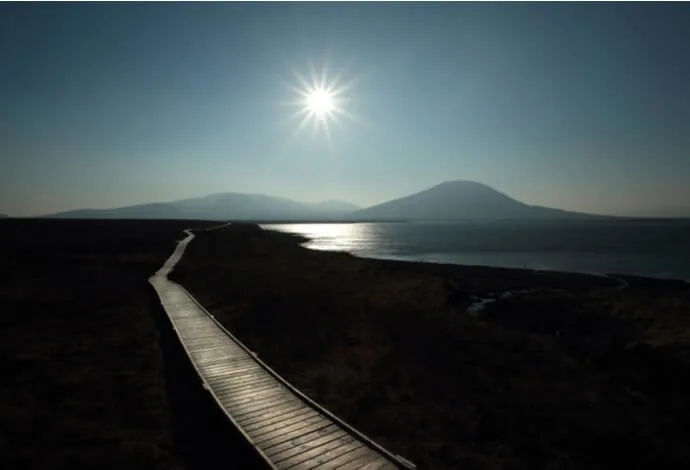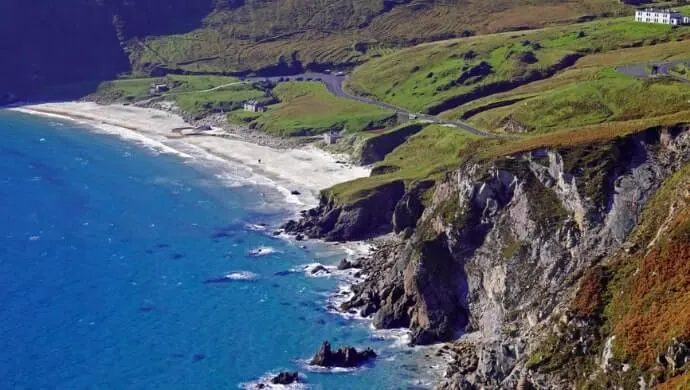A visit to Wild Nephin Ballycroy National Park is another of the many overlooked things to do in Mayo.
The area inhabited by Wild Nephin Ballycroy National Park has been a source of food and water for thousands of years.
Shaped by glaciers over 2.5 million years, the Park today, with its abundance of lakes and mountains, is a testament to the glorious creativity of nature.
There’s a mix of easy, tricky-ish and very long walks at Ballycroy, with a ramble to suit most levels of fitness. Find everything you need to know below.
Some Quick Need To Knows about Ballycroy National Park

Photo by Aloneontheroad (Shutterstock)
If you’re planning on doing one of the short Wild Nephin Ballycroy National Park walks, then a visit here is nice and straightforward.
If you want to do one of the long hikes, you need to plan carefully. Here are some quick need-to-knows.
1. Location
Ireland is well known for its peat bogs, but the one in Ballycroy National Park is one of the largest in Europe. You can find it in the Nephin Mountains area in Northwest Mayo, covering an expanse of about 118 sq km. That’s one big bog!
2. Visitor centre
Whether you’re looking for information or sustenance, the National Park Visitor’s Centre is perfectly placed in Ballycroy Village to offer both. The information is provided via an interpretative exhibition of the Park’s flora and fauna, and, for sustenance, visit the Ginger & Wild Café for its homemade food and incredible views.
3. Important habitat
Several significant habitats and species exist in the Park and require its protection and the protection offered by European initiatives such as Natura 2000 Network. Birds such as the Greenland white-fronted geese, red grouse and golden plover are some of the uncommon birds found in the Park. The very ground on which you’ll walk, known as Atlantic Blanket Bog, is itself a protected habitat
4. Shuttle bus
From Tuesday to Saturday during June, July & August, the National Park puts on a free shuttle bus between Westport and Bangor, with several stops in the Park. Hop off to take one of the looped walks (6km, 10km, or 12km), the Cleggan Mountain Coastal trail, or continue to the Visitor Centre to begin your sightseeing there.
5. Safety and proper planning
A visit to Wild Nephin requires planning and preparation, if you plan on tackling any of the longer walks, some of which stretch to 10 hours. You need a route planned, the right gear and you need to be aware of the warnings that we cover later in this guide.
About Wild Nephin Ballycroy National Park

Photos via Shutterstock
Wild Nephin Ballycroy National Park was opened in 1998 as Ireland’s sixth National Park and covers over 15,000 hectares of Atlantic Blanket Bog. Formed 2.5 million years ago by glaciers, the terrain is mountainous and wild.
Its namesake, the Nephin Beg Mountain range, dominates the landscape above, while the Owenduff Bog that you walk upon is one of the last intact and active Blanket Bog systems in Western Europe.
Habitats & Species
The National Park is home to a variety of significant flora and fauna, all of which are protected under the EU Habitats and Birds Directives. Included in these habitats and species are alpine heath, upland grassland, and lakes and river watersheds. Bird watchers, keen to see Greenland White-fronted geese, Golden Plover or Red Grouse, are rarely disappointed.
Weather
The Park covers over 15,000 hectares, and the walking trails here are lengthy, so proper planning is required ahead of time. Wild Nephin isn’t the type of place you want to be if a storm blows in off the Atlantic and you’re not adequately prepared.
Ticks (please read)
During the warmer months (summer and into autumn), you need to check for ticks when you leave the Park. Ticks are parasites, and infected ticks can cause Lyme Disease. The first indication of Lyme Disease is a raised rash-type redness that looks a bit like a bull’s eye. Other symptoms include tiredness, aches and pains, fever or chills and a stiff neck.
Things to do at Wild Nephin Ballycroy National Park

Photos via Shutterstock
There are loads of things to do at Wild Nephin Ballycroy National Park that’ll appeal to those that like to explore on foot.
From the coastal trail and the loop walks to the cafe, the visitor centre and more, here are some of our favourite things to do at Wild Nephin.
1. Grab a coffee and plan your visit
The Ginger & Wild Café is part of the Wild Nephin Visitor Centre in Ballycroy Village. It is the perfect place to get a coffee and work out where you’re going to explore in the Park.
There’s a relatively handy 2km looped walk from the centre where you’ll be treated to glorious views of Achill Island and the surrounding mountain range.
2. The Claggan Mountain Coastal Trail
Cleggan Mountain is the most southerly of the Nephin Beg range and the coastal walk trails under its shadow. The trail winds for 2km along a boardwalk through the flowering bog to the beach and invites you to take your time if it’s a fine day.
Panoramic views of Achill and the mountains are breathtaking, and your camera will be in constant use. Make your way back along the stony beach, appreciating the Blanket Bog with its myriad of colourful heathers and gorse. A small but perfectly formed walk.
3. The Letterkeen’s Walking Loops
The Letterkeen walking loops are accessed via a well-signposted road 1km out of Newport. The loops are colour-coded for fitness levels and time.
The Bothy Loop is the shortest walk at 6km and is marked in blue for a moderate fitness level. The purple and red loops also follow the same route for about 2.5km, so don’t get alarmed and feel you’re on the wrong track. Here’s more info on the trails.
4. The Bangor Trail and Wild Camping
Take your time and camp overnight along this 10-hour hike or go flat out and finish in one day. This is the largest wilderness area in Ireland, an ancient route through the Nephin Beg Mountains, and the only Irish mountain range without a road through.
The ground underfoot is boggy and wet, almost all the time. Once you leave the initial stretch of road, you see no other sign of modern civilisation until you return. Slieve Carr at 721m is the highest mountain in the Nephin Beg range and is thought (by hikers) to be the most remote summit in Ireland.
5. Mayo’s Dark Sky Park
Did you know that Mayo is recognised internationally as one of the best places in the world to view the night sky? This has been a fact since 2016 when the Ballycroy National Park was awarded a Gold Tier standard of International Dark Sky Park.
This means that on a clear Mayo night, you can see more than 4,500 stars and planets in The Milky Way, as well as meteor showers, and all without a telescope.
The process of achieving the Gold Standard was a collaborative effort between the Park and the local community. Together, they’re committed to keeping the skies dark for generations to come.
Things to do near Ballycroy National Park
One of the beauties of Ballycroy National Park is that it’s a short spin away from some of the best things to do in Mayo.
Below, you’ll find a handful of things to see and do a stone’s throw from Ballycroy National Park (plus places to eat and where to grab a post-adventure pint!).
1. Achill Island

Photo by Bildagentur Zoonar GmbH (Shutterstock)
The largest island in the country, Achill Island is accessed from the mainland via the Michael Davitt bridge. A car is best for getting around the island, but taxis are available, or you can hire a bicycle. Creatives of all types have made Achill their home over the years, and there’s a strong artistic and musical community on the island. See our guide to the best things to do in Achill for more.
2. Westport

Photo via Susanne Pommer on shutterstock
Westport prides itself on being a town that tourists love to visit. Forever linked to the pilgrimages to Croagh Patrick, visitors have been coming here for over 5,000 years. It’s a pretty town, with lovely walks along the canal and oodles of indoor and outdoor activities. See our guide on the best things to do in Westport for more.
3. Croagh Patrick

Photo via Anna Efremova
Situated about 10km from Westport, and 765m above sea level, is the Holy Mountain of Croagh Patrick. Pagans came on pilgrimage to celebrate the beginning of the Harvest season over 5,000 years ago, and these pilgrimages have continued without interruption to the present day. On the last Sunday in July, each year, upwards of 25,000 pilgrims climb the mountain in honour of St Patrick, who was said to have fasted there for 40 days and nights.
4. The Mullet Peninsula

Photo by Keith Levit (Shutterstock)
Stretching approximately 30km into the Atlantic, the Mullet Peninsula starts at Belmullet and ends at Erris Head. Several small villages break the barren landscape, and its lovely beaches attract water-sports-loving tourists. It’s a Gaeltacht area and has several summer schools teaching the Irish language. The nearby Benwee Head is also worth seeing. See our guide to the best things to do in Belmullet for more.
FAQs about visiting Wild Nephin Ballycroy National Park
We’ve had a lot of questions over the years asking about everything from are there any short walks at Wild Nephin Ballycroy National Park to what’s the story with wild camping.
In the section below, we’ve popped in the most FAQs that we’ve received. If you have a question that we haven’t tackled, ask away in the comments section below.
Is Wild Nephin Ballycroy National Park worth visiting?
Yes, if you 1, like to explore on foot, 2, love wild, unpoiled scenery and 3, like to dodge crowds, then you’ll love Ballycroy National Park.
What is there to do at Ballycroy National Park?
You can grab a coffee and plan your visit at the visitors centre, try the Claggan Coastal Trail, conquer one of the Letterkeen loop, tackle the Bangor Trail (for experienced hikers) or experience Mayo’s Dark Sky Park.
Are there any short walks at Wild Nephin?
Yes – there’s a relatively handy 2km looped walk from the centre where you’ll be treated to glorious views of Achill Island and the surrounding mountain range.
